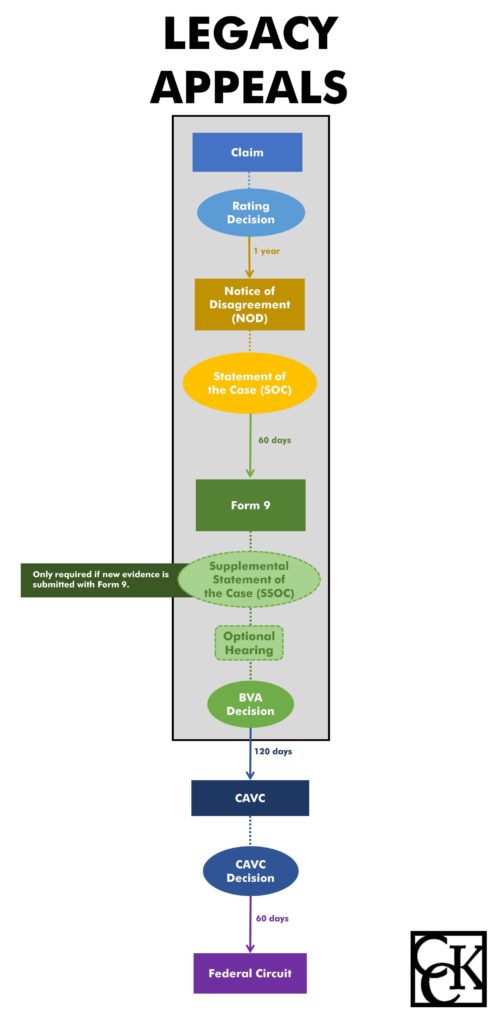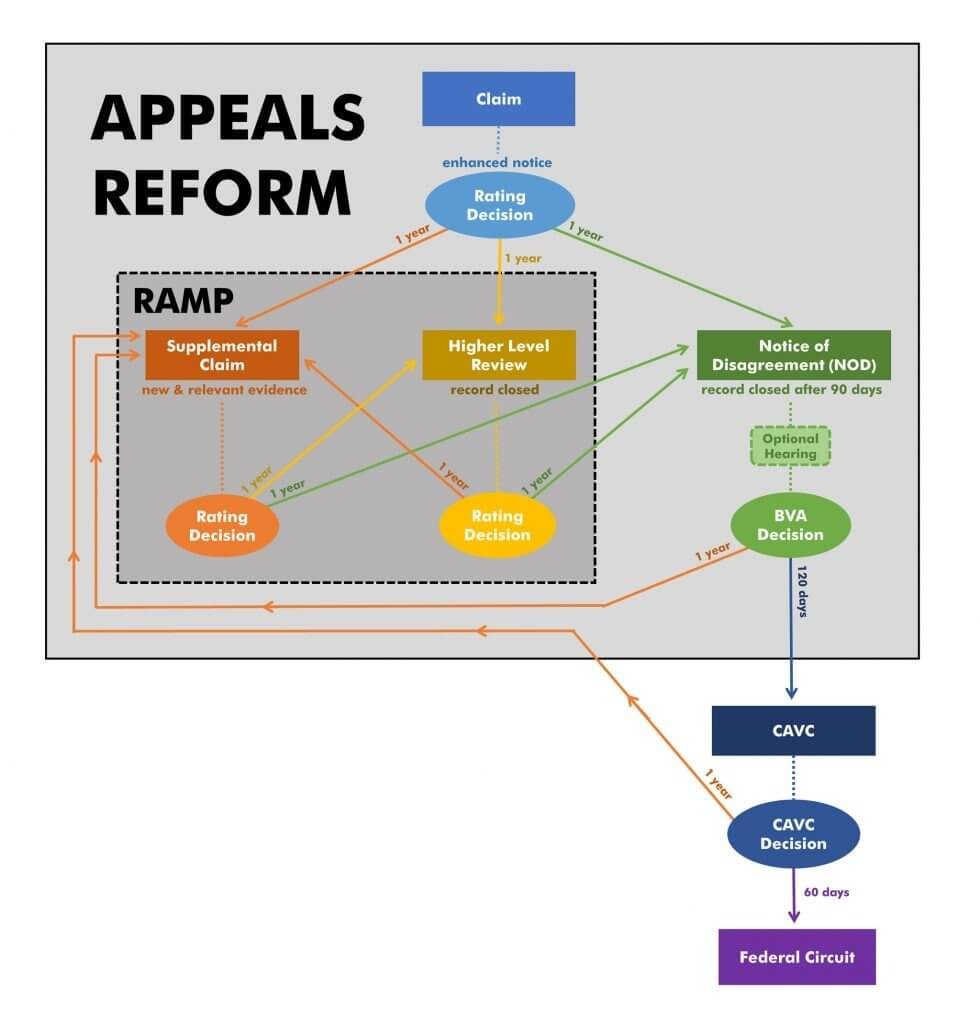Everything you need to know about the new Rapid Appeals Modernization Program (RAMP)

Introduction to RAMP
On August 23, 2017, the Veterans Appeals Improvement and Modernization Act of 2017 was signed into law, enacting veterans’ appeals reform. VA launched this bill’s pilot program, the Rapid Appeals Modernization Program (RAMP), on November 2, 2017, inviting veterans to enroll in the program. If you have not yet received a RAMP enrollment letter, you may soon.
Note: On February 19, 2019 the Veterans Appeals Improvement and Modernization Act (AMA) was officially implemented, thus ending the Rapid Appeals Modernization Program. The most up-to-date information on the AMA can be found on our page: Veterans’ Appeals Reform.
Prior to the law’s projected implementation in February of 2019, the VA will continue to send eligible veterans RAMP enrollment letters each month, eventually totaling about 350,000. After February of 2019, all new claims will be processed according to the Veterans Appeals Improvement and Modernization Act of 2017. If you receive a RAMP letter and do not respond, you will remain in the current Legacy appeals process.

Summary of Legacy
To best comprehend the Rapid Appeals Modernization Program (RAMP), it is helpful to first understand the VA’s current appellate system referred to as the Legacy appeals process. Currently, there is one “lane” in the veterans’ claims process. Generally, the following steps are involved in a veteran’s claim and subsequent appeal process:
- The veteran will file a claim.
- The Local Regional Office (RO) will issue a rating decision that grants, denies, or partially grants the claim.
- The veteran has one year to file a Notice of Disagreement (NOD), or an appeal, to contest the decision.
- The claimant then waits for a Statement of the Case (SOC), explaining why the claim was denied or only partially granted.
- A veteran has 60 days from when VA issued the SOC to perfect their appeal to the Board of Veterans Appeals (BVA) by filing a VA Form 9.
- BVA will then issue a decision granting, denying, or remanding the case for further action.
- If a veteran is appealing a further denial, they have the option to bring their case to federal court at the S. Court of Appeals for Veterans Claims (CAVC)
Because each individual veteran’s case is different, a veteran may face additional steps in their claims and appeal process.
What makes me eligible for RAMP now?
You may be eligible to enroll in RAMP if you have an appeal currently pending in one of the following stages of the legacy appeals process:
- If you have filed a notice of disagreement (NOD)
- If you have filed a VA Form 9 to appeal to the BVA
- If your appeal has been certified to the Board, but not yet activated for a Board decision.
- If your appeal has been remanded from the Board to the Regional Office (RO).
It is important to note that RAMP will be offered to veterans who have been waiting in any of the above appeal stages the longest.

What is RAMP?
The Rapid Appeals Modernization Program (RAMP) is a large-scale pilot program for VA’s new appeals process. RAMP will introduce a new, “multi-lane” system for veterans filing an appeal.
RAMP does not change the process for filing an initial disability claim with the VA, it only changes the process for appealing a decision. If a decision is issued with which a veteran disagrees, RAMP offers 3 routes by which a veteran can appeal.
Lane 1, Higher-Level Review:
If you file an appeal and choose to opt into the first lane of RAMP, you are requesting that the Regional Office (RO) issue another decision based on a “higher level of review.” According to the VA, a higher-level review of your case will be conducted by a more experienced rating specialist at the RO; this individual will evaluate your claim de novo (or look at it anew). We do not yet know whether these “more experienced” personnel at the RO will be Decision Review Officers (DRO), or just more experienced VA employees at the RO.
A higher-level reviewer has the ability to overturn a previous decision based on a number of factors, for example, if a clear and unmistakable error (CUE) is present. The RO will then issue another decision based on the same evidence of record. In this higher-level review process, the veteran is not allowed to submit new evidence supporting their claim. This brings us to the second appeal option in RAMP for veterans appeals: supplemental claims.
Lane 2, Supplemental Claims:
The second appeal option under RAMP is to select that your appeal be handled in the Supplemental claim.
Unlike the higher-level review lane, the supplemental claim lane allows the submission of new and relevant evidence (formerly known as new and material evidence).
The supplemental claim lane is the only one in which VA has a “duty to assist” veterans in gathering evidence to support their claims. The VA does not have a duty to assist during the higher-level review process, or in appeals to the Board of Veterans’ Appeals.
If a veteran would like to submit new and relevant evidence, the effective date of their claim will not change. In other words, the supplemental claim lane allows you to update your claim with new evidence, while keeping the same effective date as your initial claim. Keep in mind, however, that your original effective date will only be honored if you submit a supplemental claim within one year of the RO’s initial decision.
If a veteran filed an appeal for higher-level review and received an unfavorable decision, he or she may submit a supplemental claim with new and relevant evidence in order to enter into the supplemental claim lane. This means that you will be allowed to switch to the supplemental claim track even if you first selected the higher-level of review option and vice versa. You will also be allowed to submit a supplemental claim decision for higher-level review. It is a veteran’s legal right to switch lanes as they wish as long as all criteria is met, and a decision has been issued in the Veteran’s current appeals track.
Lane 3, An Appeal Lane for Appeals to the Board: Not available until February 2019
The third track through which a veteran may file an appeal is directly to the Board of Veterans’ Appeals. A veteran would select this track if he or she receives an initial unfavorable decision from the RO, or an unfavorable decision in either the higher-level review track or the supplemental claim track. Borrowing terminology from the Legacy appeals process, a veteran would file a Notice of Disagreement (NOD) directly to the BVA.
According to the VA’s website, this third appeals track provides veterans the ability to choose between three review options at the Board:
- If you do not have any new and relevant evidence to submit, you may select the direct review Note: Selecting the direct review option at the board does not entitle you to a hearing before a judge.
- If you have new and relevant evidence to submit to the board, but do not want to testify before a Veterans Law Judge, you may select the evidence submission
- If you wish to submit new and relevant evidence to the board and testify before a Veterans Law Judge, you may select the hearing
It is important to mention that there will be a limited window in which you may submit new evidence for your BVA appeal. Information regarding this lane (and the whole RAMP pilot in general) is limited. Those enrolled in RAMP will not be able to select this BVA appeal method until February 2019.
What opting into the pilot program (RAMP) means:
Although some veterans are being invited to enroll in RAMP now, not all lanes are open until the official implementation of the Veterans Appeals Improvement and Modernization Act, currently projected to be in February 2019. Currently, there is no way of knowing how long after February 2019 appeals will actually take to reach the Board.
Choosing to opt into RAMP will effectively withdraw your appeal from the Legacy system. Once you exit the Legacy appeal process, you cannot go back.
About the Author
Share this Post
